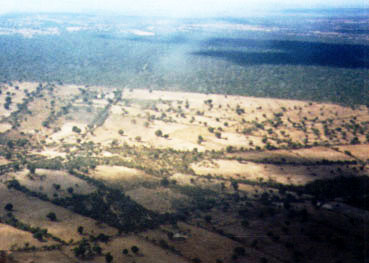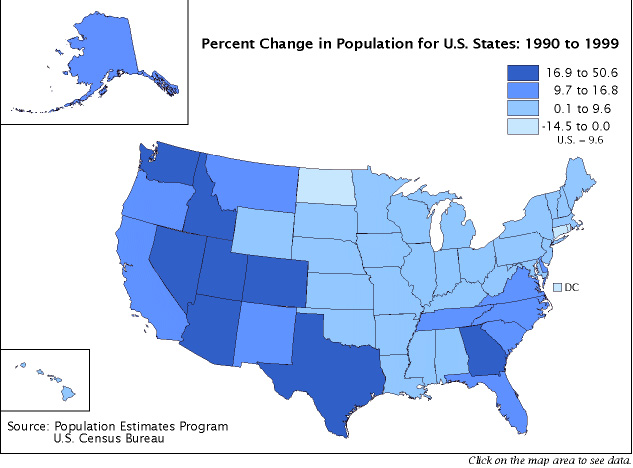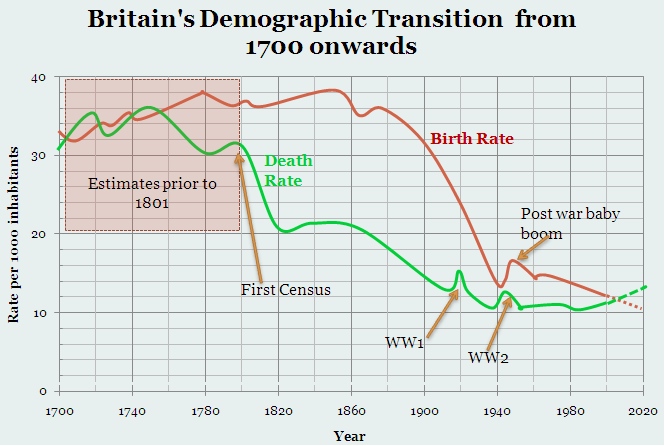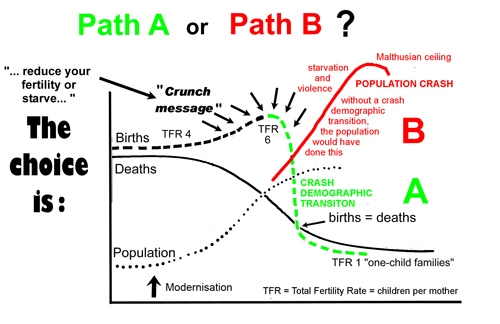 Nova: human population
Nova: human populationWorld in the balance: The People Paradox
India | Japan | USA | sub-Saharan Africa | brevity | Kenya | Transition Theory | Demographically trapped? | Conclusion
The demographic divide
- demographic changes in the future are unprecedented.
- rising longevity has never been dominant, until now.
- infant survival has reached unprecedented levels.
- there now exists the largest youthful generation ever.
- world population will move from six to nine billion in a generation.
- aging nations are in decline and younger nation verge on explosive change.
David slays Goliath: In the allegory the younger defeats the larger, older and more powerful giant. While for population study the another implication is that small things matter and can overwhelm the giant, obvious metric.
India soon will have 1.5 billion people.
Uttar Pradesh the largest province; if it were a nation would be the fifth largest nation on Earth.
177 million people in an area equivalent in size to that of Colorado and growing at 10 million per year despite the fall in fertility; although in the 1940s there were six children per woman this has declined to three children per woman currently.
"Gender lies at the heart of the problem, actually."
Nine in ten marriages are arranged during the adolescent years.
50% of the nation is under twenty-five years old.
25,000 women per year are physically abused by husbands.
There are 35 million fewer women in India today due to gender specific abortion and the Hindu custom of desiring male children.
Eight percent economic growth, despite loss of water resources and crowding.
1.6 billion by 2050 if the two child family prevails into the future.
2 billion by 2050 if the the average number of children is 2.5 per family.
India | Japan | USA | sub-Saharan Africa | brevity | Kenya | Transition Theory | Demographically trapped? | Conclusion
Population clock
Japan has experienced the greatest drop in fertility in this century.
1.3 children per family, will lead to 63 million Japanese by 2050.
By 2050, one in three Japanese will be over sixty five years old.
Men average 78 years and women 84 years of age, success has created a retirement crisis, due to a decline in consumers and a concomitant decline in tax revenues.
America --The US is the third largest nation on earth with 1,000,000 immigrants per year-- to replace the decline in domestic fertility growth.
One American child consumes as much as 30 East Indian children every year.
One in four Americans are baby boomers due to retire by 2025.
Nearly 80 percent of America is urban.
India | Japan | USA | sub-Saharan Africa | brevity | Kenya | Transition Theory | Demographically trapped? | Conclusion
Africa, south of the Sahara, will double by 2050, three times the size of Europe.
Despite high AIDS mortality

In Africa, widespread deforestation is the fastest in the world.
India | Japan | USA | sub-Saharan Africa | brevity | Kenya | Transition Theory | Demographically trapped? | Conclusion
Demographic Transition Theory
The move from high death and high birth rates declines initially with the fall in death rates, followed by a decline in birth rates. This change is accompanied by the explosion of the population over one to three generations depending on the speed of the transition, women's behavior and the average age at marriage.
The speed at which the transition occurs is crucial to a nation's success.
From an unpublished but argument-based articled by two African educators: Dan Kaseje and Richard Muga, Vice Chancellors of GLUK the Great Lakes University of Kenya.
Kenya
The average family size in Kenya has fallen from seven to four children in a generation.
Six to nine percent of all Kenyans have AIDS ; a statistic so widespread that the life expectancy has crashed from 64 to 49 years of age since the epidemic commenced.
Micro-biocides, used to stem infections of sexually transmitted diseases can bring down the incidence and spread of AIDS.
Half of all Kenyan women have a child before they are nineteen years of age.
Dan Kaseje and Richard Muga argue that:
" The two disciplines, which we declare corrupt, are demography and development economics, because they will not recognize local demographic entrapment and its extreme threat to the welfare of Middle Africa. In most of the rest of the world fertility has fallen so greatly, that there is now little cause for anxiety. [3] We are concerned with Middle Africa, where it has not fallen enough, or has not fallen at all, so that it remains at 5.9 children per mother.[4] Our population multiplied seven times during the 20th century; it has quadrupled since 1950, [5] and it is expected to more than double again by 2050.[4].
We present evidence to suggest that much of our region is demographically trapped. By this we mean that an agricultural community has already exceeded, or is about to exceed, the carrying capacity of its ecosystem, and its ability to migrate, and the ability of its economy to produce goods and services, which it can exchange for food and other essentials. In many communities in Middle Africa pressure on carrying capacity is already acute. [6]"
India | Japan | USA | sub-Saharan Africa | brevity | Kenya | Transition Theory | Demographically trapped? | Conclusion
Adolescent pregnancy and the spread of aids has at its common cause the inadequate if nonexistent sex education.
In less than 50 years five billion new people could be born.
Unless the trend to smaller families persists for another two generations, the growth will be unprecedented, if not dangerously risky
Population change
Demographics & density
NOVA: -WGBH;Boston- PBS.org
http://www.youtube.com/watch?v=6ANMPYYkkF0
Sara Holt: Writer, Director and Producer. (June 14, 2005, PBS; 8-9 PM).
Population wiki
Population clock
D. Bainbridge, The X in Sex, (Cambridge: Harvard University Press, 2003).







